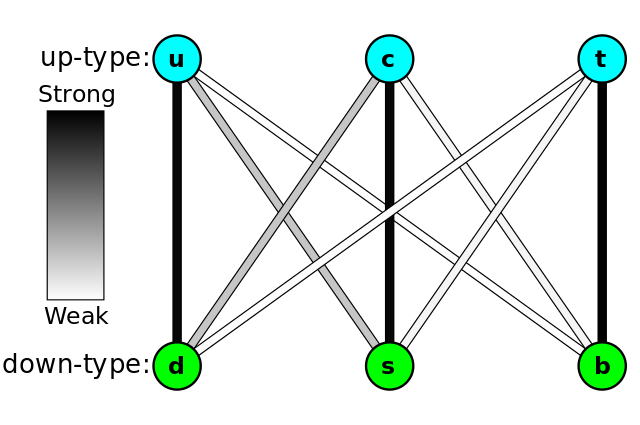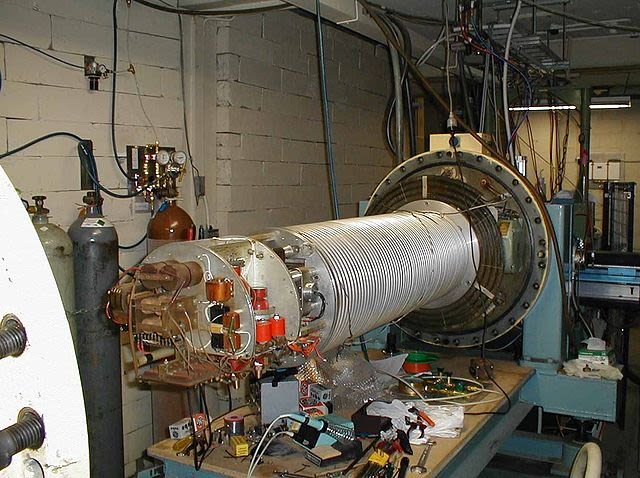Deep inelastic scattering (DIS) is an
extension of the scattering experiments like that of Geiger and Marsden that
led to the discovery of the atomic nucleus. If the alpha particles used had had
more energy they could have broken up the target nucleus, with results that
might have been too confusing to evaluate at that time. The scattering would
have been inelastic as the alpha particles lost energy in breaking up the
nucleus, rather than the elastic scattering that Rutherford was able to assume.
But in 1968 high-speed electrons were used to probe the proton (hydrogen nucleus), contained in a tank of liquid hydrogen at the Stanford Linear Accelerator Center in California. This was about the time that theory was predicting that even such fundamental particles as the proton had internal structure, and should contain smaller objects with fractional charge and baryon number. These were named as quarks by the theoretical physicist Murray Gell-Mann. The pattern of scattering of the electrons confirmed the existence of small scattering centres inside the proton. These were identified as quarks.

The interaction between particles is mediated by exchange particles, in this case by virtual photons between the incoming electron and the proton. When the electron kinetic energy is low these photons also have low energy, meaning an associated wavelength too large to ‘see’ the quarks. The electrons are scattered elastically through small angles. To resolve quarks, high-energy, short-wavelength photons are needed. When such a photon is emitted by a high-speed electron the electron recoils at a large angle. The photon also has enough energy to knock a quark out of the proton. But when quarks separate, new quarks are formed and the proton remains a three-quark object. The ejected quark breaks up into one or more quark-antiquark pairs observed as a jet of mesons.
This process of deep inelastic scattering is now one of the main tools of investigation in particle physics, with ever more massive and higher energy particle colliding with each other. The overall aim now is to find new more massive particles that can only be created with the ‘spare’ energy from inelastic collisions. I will discuss such collisions next.
Quarks and the weak interaction
In a collision, any new particles carry away kinetic energy and their rest mass-energy. Both energies are provided by the total energy of the colliding particles. I shall consider two situations involving a proton and an antiproton. In the first, the moving antiproton hits the proton which is a stationary target. In the second, both particles collide while moving with equal energies towards each other (as in a collider). The total energy of each moving particle is 2 GeV. Suppose that in each case a single particle is produced as a result of the collision. What total energy will this particle have?

A COLLISION WITH A STATIONARY TARGET
The total energy is 2 GeV for the moving antiproton plus the rest-mass energy of 1 GeV of the target proton, total 3 GeV. The total momentum is due to the incoming particle only, and is calculated from:
P2 = E2/c2 – m02c2
which gives: p2 = 3(GeV/c)2
and: p = 1.7 GeV/c
The new particle must carry away exactly this quantity of momentum. Its rest mass mnew must be given by:
m2new = E2/c4 – p2/c2 = 32(GeV/c2) – 1.72(GeV/c2)
So that: mnew = 2.5 GeV/c
This is in fact a Z particle.
COLLISIONS IN A COLLIDER
As explained above, the energy for each colliding particle is 2 GeV, totalling 4 GeV. The total momentum before collision is zero, since each particle is moving with the same speed but in opposite directions. The momentum of the new particle must also be zero. This means that its kinetic energy is zero, so all the energy must appear as the rest mass of the new particle: which is thus 4 GeV/c2.
This shows that the collider system is able to create particles of greater rest mass than the stationary target system is able to.
TIME DILATION: PARTICLES LIVE LONGER AT SPEED
Many of the new particles produced in accelerators decay with very short half-lives, and even at high speeds they would have decayed before reaching a detector except for the relativistic effect of time dilation. This effect has been explained before, (check here and here), in connection with the detection of muons produced in the upper atmosphere by cosmic-ray collisions.

A particle that would decay in 10-8 seconds should travel just 3 m in this time at speeds close to light speed. In fact they travel 66 m and can be observed in detectors that are so large that they have to be several metres from the collision point where the particle was created. This is because to a stationary observer the particle’s lifetime increases as a consequence of the special theory of relativity. To a fixed observer, the observed time Δt’ of a process occurring in a time Δt in a moving system is longer:
Δt’ = Δt/(1-v2/c2)½ = γt
A particle travelling at 0.999c would actually have a mean lifetime as observed increased from 10-8 s to 2.2 × 10-7 s, over 20 times longer, so that it can travel that much further on average.
MATTER AS WE KNOW IT
In the families of the quarks and the leptons, there are three generations. Each particle has its antiparticle. They make up all the matter and antimatter that has so far been discovered. But most of the Universe may consist of dark matter, which has not yet been identified.
AND FINALLY…
Atoms and nuclei exist because they are made of particles which cannot have the same set of quantum numbers while part of the same system. The reason why is outside the scope of Advanced level physics. This post has shown that the rules which define the behaviour of particles are due to the fundamental properties of quarks. But no one knows why quarks have these properties.
The rich variety of particles exists – and just for very short times – only in conditions of high energy such as during collisions in accelerators, in the interiors of stars and also at the time of the Big Bang. Most of the Universe makes do with protons, neutrons and electrons.
The next main goal of particle physicists is to find a particle called the Higgs boson which is important because its interaction with other particles is believed to be the source of their mass. Like all bosons, it is a ‘field particle’, which means that it carries a force of some kind.
We observe mass as something that makes it hard to accelerate something. The harder it is to accelerate, the greater the mass of the object. But imagine trying to push a sheet of aluminium in a strong magnetic field. You feel a force opposing your efforts, which we explain as being due to eddy currents excited in the aluminium by its motion through the magnetic field. If you didn’t know about magnetism and electricity, you might confuse this effect with the ‘inertial force’ that seems to stop you giving instantaneous velocity to a mass. In a similar way, the Higgs field opposes motion by exchanging virtual bosons – just as the exchange of photons mediates electromagnetic forces. The effect is to produce an interaction of some kind that appears as inertial resistance to motion. You can think of the Higgs boson as somehow making space ‘sticky’.

The theory put forward by Peter Higgs of Edinburgh University as long ago as 1964 is now seen to be very useful, as it links with the ‘theories of everything’ – superstring theory, supersymmetry and supergravity – now being explored by the ‘super-theorists. The mass of the Higgs boson is predicted to be between 0.1 and 1 TeV, so should be within the scope of the ATLAS experiment in the Large Hadron Collider at CERN.
Physics would quite like to know what causes mass – and be able to link quantum physics with Einstein’s gravity theories.
SUMMARY
After reading through all the series of my post on particle physics, starting with 1, 2, 3, 4, 5, and this final one, you should know and understand the following:
- Three particles – the neutron, proton and electron – are able to explain the main behaviours of stable atoms.
- The four types of interaction between particles require additional exchange particles – bosons – which mediate the interactions (they ‘carry the forces’).
- Many new particles have been discovered, initially from the collisions of cosmic rays (high-speed protons, electrons and atomic nuclei) and later from accelerator experiments.
- Each particle has an antiparticle, described as matter and antimatter.
- Particles and their antiparticles – hadrons (baryons, mesons) and leptons – are classified by rest mass and by other properties (baryon number, strangeness) and their response to forces.
- These properties were discovered by applying conservation rules in reactions.
- The behaviour, interactions and nature of hadrons may be explained more simply using the quark model.
- There are three lepton families and three quark families, arranged in successive generations.
- There are several types of accelerator, each based on a physical principle. Accelerators give particles high energies at which they interact.
- Many investigations involve deep inelastic scattering.
- There are several types of particle detector, each design based on a particular underlying physical principle but usually relying on the ability of a particle to cause ionisation.
- For simple reactions there are calculations and decays involving the masses, energies and momenta of high-speed, relativistic particles.
- Conservation rules enable particle interactions to be analysed.
- Feynman diagrams can be used to illustrate what happens in interactions and decays involving particles.
REFERENCES
https://www.worldscientific.com/worldscibooks/10.1142/4814
https://www.worldscientific.com/worldscibooks/10.1142/4586
http://www.tunl.duke.edu/nnpss/lectures/11/NNPSS11-2-nobuilds.pdf
https://en.wikipedia.org/wiki/Deep_inelastic_scattering
http://hyperphysics.phy-astr.gsu.edu/hbase/Forces/funfor.html
https://www.britannica.com/science/weak-force
https://www.livescience.com/49254-weak-force.html
https://en.wikipedia.org/wiki/Weak_interaction
http://hyperphysics.phy-astr.gsu.edu/hbase/colsta.html
https://www.symmetrymagazine.org/article/whats-really-happening-during-an-lhc-collision
https://en.wikipedia.org/wiki/Collider
http://www.schoolphysics.co.uk/age16-19/Relativity/text/Muons_time_dilation/index.html
https://en.wikipedia.org/wiki/Experimental_testing_of_time_dilation
https://en.wikipedia.org/wiki/Time_dilation
https://home.cern/science/physics/higgs-boson
https://en.wikipedia.org/wiki/Higgs_boson
This post has been voted on by the SteemSTEM curation team
and voting trail. It is elligible for support from @curie and @minnowbooster.
If you appreciate the work we are doing, then consider supporting our witness @stem.witness. Additional witness support to the curie witness would be appreciated as well.
For additional information please join us on the SteemSTEM discord and to get to know the rest of the community!
Thanks for having used the steemstem.io app and included @steemstem in the list of beneficiaries of this post. This granted you a stronger support from SteemSTEM.